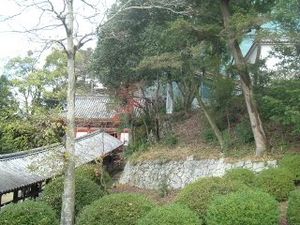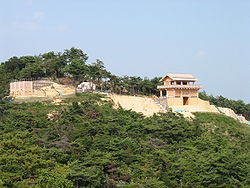
Kingdom of Kibi
Encyclopedia

Japan
Japan is an island nation in East Asia. Located in the Pacific Ocean, it lies to the east of the Sea of Japan, China, North Korea, South Korea and Russia, stretching from the Sea of Okhotsk in the north to the East China Sea and Taiwan in the south...
that acted as a cultural bridge between the Yamato
Yamato
Yamato was originally the area around today's Sakurai City in Nara Prefecture of Japan. Later the term was used as the name of the province and also as an ancient name of Japan...
state and the various kingdoms of the Korean peninsula
Three Kingdoms of Korea
The Three Kingdoms of Korea refer to the ancient Korean kingdoms of Goguryeo, Baekje and Silla, which dominated the Korean peninsula and parts of Manchuria for much of the 1st millennium...
. The Kingdom of Kibi covered most of what is today Okayama Prefecture
Okayama Prefecture
is a prefecture of Japan located in the Chūgoku region on Honshū island. The capital is the city of Okayama.- History :During the Meiji Restoration, the area of Okayama Prefecture was known as Bitchū Province, Bizen Province and Mimasaka Province.- Geography :...
. Today, the Kibi Road crosses the plain between Okayama and Soja, what was once the heartland of Kibi-no-kuni.
Kibi was strategically located on the inland seaway between Korea and Yamato. The kingdom's strong influence on the Yamato administration, and the presence of Korean noblemen in the government of the ancient kingdom, would cause a chain of events that ended with the disintegration of Kibi.
Etymology
Though in modern times the word kibi describes millet, the original word Kibi which appears in the KojikiKojiki
is the oldest extant chronicle in Japan, dating from the early 8th century and composed by Ō no Yasumaro at the request of Empress Gemmei. The Kojiki is a collection of myths concerning the origin of the four home islands of Japan, and the Kami...
and in the Nihonshoki (the oldest records of Japan) has been lost in the modern language
Japanese language
is a language spoken by over 130 million people in Japan and in Japanese emigrant communities. It is a member of the Japonic language family, which has a number of proposed relationships with other languages, none of which has gained wide acceptance among historical linguists .Japanese is an...
. The Chinese characters
Kanji
Kanji are the adopted logographic Chinese characters hanzi that are used in the modern Japanese writing system along with hiragana , katakana , Indo Arabic numerals, and the occasional use of the Latin alphabet...
used for writing the word have been in use for over 1200 years and even though phonetically they resemble the word for "millet", the characters used are different.
Legendary Kibi
Kibi has been associated with the local legend of Kibitsu-Hiko no mikoto, a legendary prince who fought the ogre "Ura", said to have lived in Kinojō CastleKi castle
was a Japanese castle of the kōgoishi type, constructed in the late 7th century by the Yamato Imperial court. The site, atop Kijō Mountain in what is today the Okayama Prefecture town of Sōja, is considered a national monument...
(Demon castle) near the city of Sōja
Soja, Okayama
is a city located in Okayama Prefecture, Japan.As of April 30, 2011, the city has an estimated population of 67,357, with a household number of 24,623, and the density of 317.72 persons per km². The total area is 212.00 km².The city was founded on March 31, 1954...
.

Historical Kibi
Archaeological research of many temples and shrine ruins, as well as burial mounds, suggests that the ancient kingdom was as developed and powerful as the Yamato administration that controlled Japan in the eighth century. The center of power of the Kibi Kingdom was located on the Kibi plain between Soja and Okayama.The evidence of Kibi's importance in the fourth and fifth centuries is proven by the hundreds of kofun
Kofun
Kofun are megalithic tombs or tumuli in Japan, constructed between the early 3rd century and early 7th century. They gave their name to the Kofun period . Many of the Kofun have a distinctive keyhole-shaped mound , unique to ancient Japan...
(tumuli) found in the area. A hereditary and aristocratic social structure followed more the Korean and Japanese sophisticated form of society, than the Chinese ways. Even after Kibi was subjugated, the descendants of Kibi's chieftains remained very influential.
In the Yayoi period
Yayoi period
The is an Iron Age era in the history of Japan traditionally dated 300 BC to 300 AD. It is named after the neighbourhood of Tokyo where archaeologists first uncovered artifacts and features from that era. Distinguishing characteristics of the Yayoi period include the appearance of new...
, Kibi had great influence in local matters. Kibi was situated in a strategic point between the Tsukushi
Tsukushi
Tsukushi may refer to:*Tsukushi Province, old Japanese province, subsequently divided into**Chikuzen Province, old Japanese province, part of Fukuoka Prefecture without south and east Fukuoka...
tribes of the south and the Kinki tribes of the east, controlling all the flow of vital supplies in the area.

